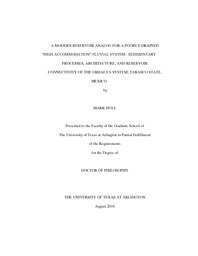
ATTENTION: The works hosted here are being migrated to a new repository that will consolidate resources, improve discoverability, and better show UTA's research impact on the global community. We will update authors as the migration progresses. Please see MavMatrix for more information.
Show simple item record
| dc.contributor.advisor | Nestell, Merlynd K. | |
| dc.contributor.advisor | Holbrook, John | |
| dc.creator | Hull, Mark | |
| dc.date.accessioned | 2017-09-12T15:01:38Z | |
| dc.date.available | 2017-09-12T15:01:38Z | |
| dc.date.created | 2016-08 | |
| dc.date.issued | 2016-09-12 | |
| dc.date.submitted | August 2016 | |
| dc.identifier.uri | http://hdl.handle.net/10106/26907 | |
| dc.description.abstract | High-accommodation fluvial systems are subject to much modeling and substantial rock drilling and imagination, but limited modern field observation. The Grijalva River system of Tabasco State, Mexico offers the opportunity to study these systems. In this area, subsidence rates of up to 9 mm/year result in high-accommodation conditions for the river as it approaches the Gulf Coast in southern Mexico. Lakes and small propagating channels, similar to what are commonly called “tie” channels, dominate the flood basin between major channel belts. Understanding of the co-evolution of lakes and tie channels is key to understanding the overall high-accommodation system.
Tie channels connect the floodplain lakes to the main river channel, and allow for the exchange of water and sediment into and out of the lakes. Tie channels also are instrumental in the filling/death of the lake. Tie channels propagate across lakes as deltas. The process of tie-channel propagation is still poorly understood. Nonetheless, once the tie channel reaches the other side of the lake, the lake is now bisected by the narrow alluvial ridge emplaced by tie-channel propagation, and the lake is bisected with respect to water and sediment, except during the rainy season. Asymmetry in sediment input now leads to the fill of compartments within the lake formed by tie-channel bisection, rather than overall aggradation of the lake as a whole.
This phenomenon is best exemplified in the area of study by the Pantanos de Centla. At this location, a tie channel propagated across the floodbasin lake in an orientation parallel to the main Grijalva River approximately 20 years ago. After the lake was compartmentalized by the tie channel, splay sediments from the adjacent Grijalva River could only reach the new northern compartment. This northern compartment is now filled and has evolved into a vegetated glade, while the southern compartment remains as a lake. Filling of the northern compartment now permits bypass of sediment from the Grijalva River into the southern compartment which has begun filling with splay delta sediment. Close examination of high-accommodation flood basin systems in the Grijalva River reveal that deposition in flood basins is characterized by local rapid aggradation of sites and compartments rather than a uniform aggradation across the floodbasin. The co-evolution of tie channels and flood basin lakes are key elements of this aggradational process. | |
| dc.format.mimetype | application/pdf | |
| dc.language.iso | en_US | |
| dc.subject | Tie channels | |
| dc.subject | High-accommodation | |
| dc.title | A MODERN RESERVOIR ANALOG FOR A POORLY DRAINED “HIGH ACCOMMODATION” FLUVIAL SYSTEM: SEDIMENTARY PROCESSES, ARCHITECTURE, AND RESERVOIR CONNECTIVITY OF THE GRIJALVA SYSTEM, TABASCO STATE, MEXICO | |
| dc.type | Thesis | |
| dc.degree.department | Earth and Environmental Sciences | |
| dc.degree.name | Doctor of Philosophy in Earth and Environmental Science | |
| dc.date.updated | 2017-09-12T15:01:41Z | |
| thesis.degree.department | Earth and Environmental Sciences | |
| thesis.degree.grantor | The University of Texas at Arlington | |
| thesis.degree.level | Doctoral | |
| thesis.degree.name | Doctor of Philosophy in Earth and Environmental Science | |
| dc.type.material | text | |
Files in this item
- Name:
- HULL-DISSERTATION-2016.pdf
- Size:
- 5.601Mb
- Format:
- PDF
This item appears in the following Collection(s)
Show simple item record


